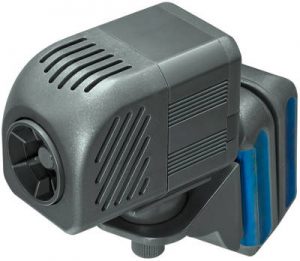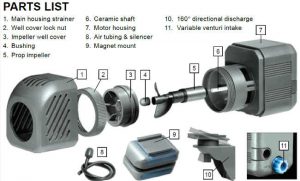
View On Amazon
| Size | Dimensions | Tank Size | Noise Level | Longevity | Price |
| 1000 GPH | 4.2″ x 2.1″ x 2.6″ | 50-100 Gallons | Low | 2-6 Years | Medium |
The Seio P1000 manages to be more than the standard powerhead. Its compact design, Even water flow distribution and overall reliability are not something you’d get from the standard Maxi-Jet.
The Seio is distributed, but not produced by Rio. They do not suffer from the constant failures of Rios, which is the main worry of those looking into this powerhead.
Set-up

Setting up the Seio P1000 is a simple, three step process that can practically be done blindfolded. First you will need to remove the front grate of the powerhead. this comes off easily, no tools or extreme force required.
Next you will need to slide the mounting bracket into place on the bottom of the powerhead. This is then secured in place by reattaching the front grate.
The last step is to put the powerhead into place. This requires the use of the two strong magnets, which you must keep separate at all times. These magnets are strong enough to work with up to 1/2″ thick glass.
The safest way to place the magnets is to hold the interior magnet and powerhead in place inside the aquarium. This is followed by bringing the top magnet to the glass just above the interior magnet. You will then slide the magnet down the glass in to place. If you bring the magnet directly towards the interior magnet you risk them pulling together suddenly. This can crack or even shatter the aquarium glass.
Keep in mind that the cord is 6 feet long. This gives you a decent amount of wire to work with, but not so much you can place it anywhere in a 100 gallon.
As a last note the Seio features a venturi intake, which injects air into the water column. This is a great feature for freshwater tanks, as it removes the need to an air pump. My main issue here is that the provided air tubing is really short, limiting the powerhead to just a few inches under the waters surface.
Assembly

Taking apart the Seio P1000 is a bit more difficult than most powerheads, as it has a couple extra pieces protecting the impeller. To start you will need to unplug and remove the powerhead. remember there is an external magnet. Remove this too and place it somewhere safe.
The first two pieces that are removed are the main housing and well cover lock nut.
Next up is the impeller well cover. Removing this give you access to the impeller and ceramic shaft. These are the main two components you will need to keep clean to ensure a long lifetime.
To clean them you will need to soak the two in a 50/50 mixture of vinegar and water. These should be left to soak for 15 minutes, followed by a quick rub down with soft materials. A quick rinse and the two are ready to return to the aquarium.
The rest of the components should be scrubbed clean while the impeller and ceramic shaft soak. While they are not mechanized, excess algae can make the next cleaning much more difficult and even restrict water flow.
Design
The Seio P1000 is a box shape, which does a few things that rounded powerheads cannot.
The first thing, and by far most noticeable, is the water distribution. Many users feel that this pump does not give the 1000 GPH that they are expecting. This is because the water is so evenly distributed. The force behind the current feels extremely gentle, leading many to think it is just weak.
The second benefit of the box shape is the protection on all sides of the powerhead. Unlike rounded powerheads, the Seio P1000 has only the smallest of slits on the side. With the excess surface area the box provides there is still enough space for the powerhead to draw in all the water it needs, however small, slow swimming fish are completely protected by this casing. Of course at 1000 GPH you certainly can’t keep a betta with the Seio.
Flow & Adjustments
The flow speed on the Seio is not adjustable. Furthermore it is not advisable to use this as a wave maker. It creates a fair bit of noise on start up but runs quietly after that. Frequent start-ups will cause excess wear on the impeller, shortening its lifetime.
The powerhead itself can only be directed in 160 degrees. This however can be remedied by turning the base the powerhead rests on. This will give you full 360 degree control. Just remember to turn both the interior and exterior magnet at the same time.
Warranty & Lifetime
Seio provides a 6 month warranty, which covers failures and faulty parts. As previously stated the main component to watch for is the impeller and ceramic shaft. These parts are what breaks 9/10 times. If they do break, and your powerhead is no longer protected by the warranty, it is fairly simple to custom order the part.
When well cared for the Seio P1000 should see between 4 and 6 years of lifetime. If it goes unwashed, then the lifetime is all up to chance and can be reduced to even 6 months. As powerheads run constantly they are extremely susceptible to debris build up and must be cleaned every month or two.